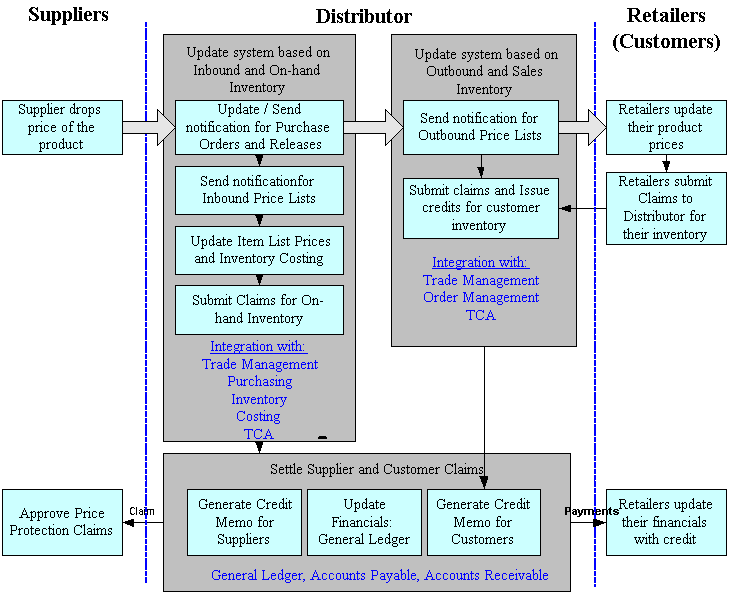Understanding Price Protection
This chapter covers the following topics:
Overview
In the high-tech distribution market, price protection agreements between suppliers and distributors, and distributors and customers are very common. However, the details of which products and how many are protected vary widely across the industry. Products and product quantities that are protected by price protection agreements make up the covered inventory of the distributor. This includes products across various warehouses and is not the same as the on-hand inventory. The covered inventory of a distributor or customer is the inventory that is eligible for claim processing.
The distributor can, when creating a price protection transactio,n make adjustments to the inventory covered by the price protection agreement in the following ways:
-
Manually adjust the total quantity of covered inventory
-
Include or exclude warehouses
-
Include or exclude inventory quantities received for a selected warehouse
These adjustments can stem from an increase or decrease in product prices and may or may not require supplier approval. The distributor can make these adjustments for a future-dated price protection transaction to get an idea of the on-hand inventory as opposed to the covered inventory and how to minimize the difference between the two inventories and have maximum coverage. All such adjustments for future-dated transactions are overwritten on the effective start date, when the system recalculates covered inventory based on the effective start date, days covered, and on-hand inventory.
If suppliers decrease the price of a product and the distributor accepts the price change, this can cause a loss in value in the distributor's on-hand inventory and in turn in the customer's on-hand inventory. To recover this loss, the distributor can raise a supplier claim for the distributor on-hand inventory.
To recover the loss of value on customer's on-hand inventory, the customer submits inventory information to the distributor. Based on this inventory data, the distributor calculates the lost value and issues a credit to the customer. The distributor then submits a customer claim to the supplier to recover from the supplier the money that the distributor paid to the customer. These supplier and customer claims may or may not require supplier approval. Financial records must be updated to reflect the impact of claims, liabilities, and credits associated with the price protection transaction.
For an increase in the price of a product, the application raises a supplier claim for the price increase and develops a sales invoice for the supplier. To enable claim creation for price increase transactions, you must select the Create Claims for Price Increase check box on the Supplier Trade Profile page of the Oracle Channel Revenue Management application.
In addition, when a product price change occurs, many systems must be updated with the new price, and records must be balanced for updates as defined by the price protection transactions as shown in the following diagram.
Important: Oracle Channel Revenue Management is a prerequisite for Oracle Price Protection.

After a distributor accepts a product price change from a supplier, the Price Protection Analyst (PPA) identifies which products and how many of those products are protected by the price protection transaction. Starting with the distributor's inventory, the PPA updates the distributor's systems to account for the new price.
-
All open purchase orders without receipts are updated depending on the status to reflect the new prices. For purchase orders with partial receipts, notifications with the new prices are sent.
-
The distributor's on-hand inventory may have lost value because of the price change. This lost value is protected by the price protection agreement between the supplier and the distributor. The lost value is calculated and a claim is generated straightaway if you did not select the Claims Pre-Approval required check box on the Supplier Trade Profile page.
-
Costing and inventory systems are updated along with item list prices to reflect the new price of products.
-
The Purchasing and Pricing departments are notified of the product price changes to update inbound, outbound price lists, and customer promotions.
These updates and notifications occur as a part of the execution processes that you initiate from the Execution Details tab of a price protection transaction.
The Pricing department is notified of the product price change so that the outbound price lists can be updated. Based on the details of the price protection transaction between customers and the distributor, the Pricing Analyst (PA) determines the new outbound price for the product.